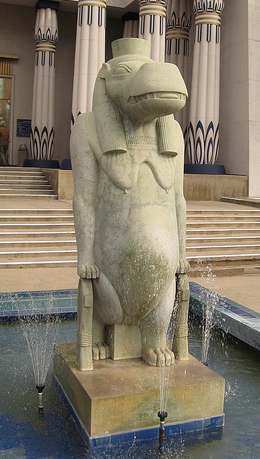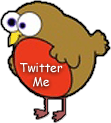Here’s another picture, where the resemblance is especially clear:

Taweret, the hippo fertility goddess. in the Rosicrucian Museum in San Jose, California. Photo by Tom Fowler
The round thing on top of this statue’s head is identical to the one on “our” statue. The ears are very similar. The toes — I count four.
It’s no wonder that in LaFleur we could see the statue only from the back — look how distinctive the front is! One glimpse of the front, with its pregnant belly and its hippopotamus face, would have given it all away.
Here are some interesting things about Taweret (sometimes spelled Tauret or Taurt) from the site Ancient Egypt Online:
Taweret … was a patron of childbirth and a protector of women and children….
Initially she was viewed as a dangerous and potentially malignant force…. She represented the … stars of Ursa Minor and Draco … who guarded the northern sky. The northern sky was thought to be cold, dark and potentially dangerous …. However, by the Old Kingdom she was seen as a protective rather than an aggressive force…. As a result, Taweret became a mother goddess and a patron of childbirth….
She was thought to help women in labor and to ward off evil spirits and demons who intended harm to mother or baby….
According to “The Book of the Dead”, Taweret guarded the paths to the mountains of the west which led to the underworld and could also use magic to help the deceased pass safely through that dangerous and frightening land.
Expectant mothers often carried amulets depicting Taweret to invoke her protection….
She was associated with so called “magic wand” or “magic knives” used during labour to ward off evil….
She was depicted as the combination of a crocodile, a hippo and a lion…. She had the paws of a lion, the back of a crocodile and the head and body of a pregnant hippo but with the addition of a woman’s hair. She often wears a short cylindrical headdress topped by two plumes or the horns and solar disk of Hathor, bearing the “Sa” (representing protection) or the ankh (representing life)…..
With so many things about Taweret relating directly to the story of LOST, I think there can be little doubt that the Island statue was based on statues of Taweret. The only remaining question is whether the writers meant for the Island statue to be a statue of Taweret herself (and if so, would that mean the Island was at one time populated by ancient Egyptians?) — or whether the writers used Taweret as a jumping off point, an inspiration to create their own original mythological being.
Photo of the Goddess statue at the Rosicrucian Museum (c) Tom Fowler









